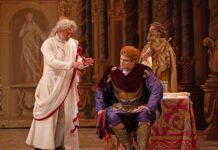By John Hill
NEW YORK (world-architects.com) — Saint Sarkis Armenian Church, located in the north Dallas suburb of Carrollton, has received the most votes in our poll for US Building of the Year 2022. Designed by David Hotson Architect, the church reaches far back in time and thousands of miles across the globe to link itself with Armenian traditions and people.
Saint Sarkis Armenian Church was consecrated on April 23, 2022, and held its first Sunday service one day later, on April 24, the traditional day for commemorating the 1.5 million victims of the 1915 Armenian Genocide. The small church — small especially in comparison to the megachurches littering the Dallas–Fort Worth metroplex — is far from Armenia, about 7,000 miles, but some members of the church’s growing congregation are descended from the Armenians who fled their home country after World War I.
The importance of history and tradition in the Armenian Orthodox Church extends to the design of Saint Sarkis Armenian Church, which derives its form from the 7th-century Saint Hripsime Church near the Armenian capital of Yerevan and memorializes the genocide in an image of the Armenian “tree of life” composed of exactly 1.5 million circular icons — each one unique, like the lives that were taken over a century ago.

As we described the church when it was featured as US Building of the Week on April 25, just two days after its consecration, the design “melds ancient forms and contemporary technologies to express the church’s Armenian roots and memorialize the victims of the genocide.” The image on the west facade, seen above, was printed by the Italian company Fiandre in high resolution on UV-resistant porcelain panels. Furthermore, a Grasshopper script guaranteed each icon was unique and their distribution resulted in a legible overall image.

The abstraction of Saint Hripsime Church — itself an austere, monolithic mass built entirely of stone — involved matching three main materials on the exterior: precast concrete walls, glass fiber reinforced concrete light coves, and standing seam zinc roofing. Inside, references to the stone dome and vaults of the 7th-century church are rendered as double-curved plaster vaults made with glass-fiber-reinforced gypsum: historically inspired shapes and modern surfaces created with contemporary means.










